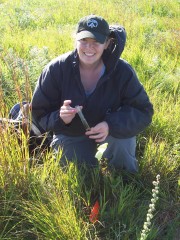Restoring Grasslands

South Dakota State University graduate student Laura Winkler collects specimens to determine the diversity of ant populations in restored grasslands in eastern South Dakota. Her research will help scientists track the progress of U.S. Fish and Wildlife Services restoration efforts.
When it comes to restoring grasslands, ecologists may have another way to evaluate their progress—ants.
The more diverse the ant population, the closer a restored section of grassland is to its original state, according to Laura Winkler, who recently completed her master’s degree in plant science, specializing in entomology, at South Dakota State University. When it comes to native grasslands, ants are “ecosystem engineers.”
Ecological role of ants
Ants play many ecological roles, Winkler explained. “They aerate the soil, cycle nutrients and play a role in plant defense and seed dispersal. Ants move more soil than earthworms, plus they are food for lots of reptiles and birds.”
Some ant species support colonies of plant-feeding insects, such as aphids or plant hoppers, even protecting them from predators. “It’s like having dairy cattle,” Winkler said. Through this technique, the ants consume the sugar-rich honey dew the aphids secrete, much as humans use cow’s milk. When the ants are in need of protein, they simply eat the aphids.
Ants also distribute organic matter by moving dead insects into the colonies and their dead nest mates away from the colonies, Winkler added.
Comparing restored, undisturbed grasslands
Winkler compared tracts of restored grasslands to undisturbed ones at three sites in eastern South Dakota–Sioux Prairie in Minnehaha County, Oak Lake Field Station in Brookings County, and Spirit Mound in Clay County. The U.S. Fish and Wildlife Service manages the restored areas, while the undisturbed area at Sioux Prairie is managed by the Nature Conservancy, Oak Lake by SDSU and Spirit Mound by the S.D. Game, Fish and Parks Department.
Originally from Des Moines, Iowa, she began working with ants as an undergraduate at Iowa State University focusing on how burning and grazing affect species diversity. Her SDSU graduate research assistantship on ant biodiversity and natural history was funded through the Meierhenry Fellowship. Her research adviser was entomologist Paul J. Johnson, professor of plant science.
Variation with age
The U.S. Fish and Wildlife Service sites that had once been crop or pasture land were restored anywhere from one to four years ago, according to Winkler. This involved taking the areas down to the bare ground and then seeding native grasses. Winkler used data from multiple sites taken over a one-year period.
As expected, the younger sites had fewer ant species, with the numbers and diversity increasing over time. The restoration areas at age 1 had seven different species, while at age 2, the number had increased to nine and by age 3 to 10 species, Winkler reported. She expected the fourth year restorations to be even closer to the 17 species present in the undisturbed remnants, but what she saw was a slight decrease to eight species.
“The drought last year and then a wet spring also affects that vegetation, what’s going to survive and how many of the ants are out foraging,” Winkler pointed out.
She suspects that management techniques may also have played a role. “Some sites may have been burned more frequently,” she noted, to control weeds.
“We’ve got a sneak peek of what can happen,” Winkler said, but more long-term research is needed. Based on other research, she anticipates that the restored areas should peak in terms of species diversity within seven to eight years.
Increased specialization
Winkler also looked at how these ant species function. The younger restorations areas tend to have ants that are generalists who can go anywhere, but the older restorations tend to have more specialists, such as soil-dwelling ants, who are more particular about where they live, Winkler explained. The more dominant specialists push out some of the generalists.
“You’ll have ants everywhere,” she pointed out, but the greater the diversity, the more niches are being filled, and the more successful the restoration effort.
About South Dakota State University
Founded in 1881, South Dakota State University is the state’s Morrill Act land-grant institution as well as its largest, most comprehensive school of higher education. SDSU confers degrees from eight different colleges representing more than 175 majors, minors and specializations. The institution also offers 29 master’s degree programs, 13 Ph.D. and two professional programs.
The work of the university is carried out on a residential campus in Brookings, at sites in Sioux Falls, Pierre and Rapid City, and through Cooperative Extension offices and Agricultural Experiment Station research sites across the state.
Media Contact
All latest news from the category: Ecology, The Environment and Conservation
This complex theme deals primarily with interactions between organisms and the environmental factors that impact them, but to a greater extent between individual inanimate environmental factors.
innovations-report offers informative reports and articles on topics such as climate protection, landscape conservation, ecological systems, wildlife and nature parks and ecosystem efficiency and balance.
Newest articles

Long-sought structure of powerful anticancer natural product
…solved by integrated approach. A collaborative effort by the research groups of Professor Haruhiko Fuwa from Chuo University and Professor Masashi Tsuda from Kochi University has culminated in the structure…

Making a difference: Efficient water harvesting from air possible
Copolymer solution uses water-loving differential to induce desorption at lower temperatures. Harvesting water from the air and decreasing humidity are crucial to realizing a more comfortable life for humanity. Water-adsorption…

In major materials breakthrough
UVA team solves a nearly 200-year-old challenge in polymers. UVA researchers defy materials science rules with molecules that release stored length to decouple stiffness and stretchability. Researchers at the University…



